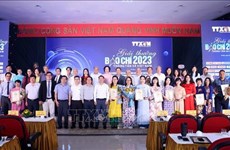Tourism helps traditional arts thrive
n the five years since HCM City began to back the idea of
developing traditional arts as a tourist attraction, some private art
troupes have hit pay dirt.
In the five years since HCM City began to back the idea of
developing traditional arts as a tourist attraction, some private art
troupes have hit pay dirt.
The Rong Vang (Golden Dragon) Water Puppet Theatre, which opened in 2007, has become a favourite tourist site in the downtown area.
Located within the Workers Cultural Palace in District 3, the theatre puts on two shows every night, attracting around 120 people.
Its owner Huynh Anh Tuan and his staff work very hard to ensure quality performances of the unique Vietnamese art of water puppetry.
In a recent interview with Sai Gon Giai Phong (Liberated Sai Gon) newspaper, Tuan said: "The country's rich and diverse traditional theatre, puppetry in particular, should be made more accessible to tourists, so that it attains value and develops."
He is building a new theatre at a cost of 2 billion VND (nearly 100,000 USD), also in the Cultural Palace , expected to be completed later this year.
The Non La (Conical Hat) Theatre's troupe of more than 50 singers, dancers, and musicians will offer audiences traditional Vietnamese music and dance.
Vuong Tuan Hung, a theatre director with 20 years' experience in the entertainment industry, said shows meant for tourists should have professional producers and stage managers and quality stagecraft.
He got the idea of opening a traditional performance company one day in 2006 while working for a tourist company in Hanoi , he revealed.
"Many foreign visitors wanted to see a traditional music performance, but we could not satisfy their need," he recalled.
"Everything available at that time was inauthentic or simplistic."
He felt compelled "to do something," and decided to explore opportunities in HCM City .
Hung and some of his close friends made something of a name for themselves with Minh Khang, the city's first company to organise and produce traditional music shows for foreign tourists.
The troupe's highlights were Cham, Co Tu, and E De ethnic minority dances, and performances on traditional instruments like dan bau (monochord) and tam thap luc (a zither with 36 brass strings).
Unfortunately, Minh Khang had to close in 2008 after losing more than 400 million VND (200,000 USD). Since it failed to attract enough audiences, it could not earn enough to remain in business.
Hung has understood why this happened, saying "We went about our business without support from tourist companies. Therefore, we found it hard to attract customers."
Linh Huyen, owner of the Me Kong Artists Company, agreed with Hung, saying that while traditional Vietnamese theatre has always held foreign tourists' interest, few tour programmes offered by local agencies included such performances.
"Unbelievably, very few of the 600 art troupes and performance companies in the city have been able to find a way to carry on business."
She also agreed that foreign visitors loved traditional Vietnamese art and wanted to know more about it.
Tourism could revive traditional arts by helping them succeed commercially, she added.
She set up a company last month to offer a traditional arts show to tourists in cooperation with the Organising Centre for Art Performances and Saigontourist.
The show, Hon Viet (The Soul of Vietnam), featuring a mix of musical and dance styles from the northern, southern, and central regions is being staged twice a month at the city's Opera House.
Their audiences so far, besides foreign tourists, have mostly been music students, teachers, artists, and researchers who pay a nominal 80,000 VND. Foreigners pay around 10 USD.
"Private companies like Rong Vang and Me Kong have invested a lot in both money and human resources to develop their art as well as diversify the city's tourism products," Vo Trong Nam, deputy director of the Department of Culture, Sports and Tourism, said.
"Their efforts have finally paid off."./.
The Rong Vang (Golden Dragon) Water Puppet Theatre, which opened in 2007, has become a favourite tourist site in the downtown area.
Located within the Workers Cultural Palace in District 3, the theatre puts on two shows every night, attracting around 120 people.
Its owner Huynh Anh Tuan and his staff work very hard to ensure quality performances of the unique Vietnamese art of water puppetry.
In a recent interview with Sai Gon Giai Phong (Liberated Sai Gon) newspaper, Tuan said: "The country's rich and diverse traditional theatre, puppetry in particular, should be made more accessible to tourists, so that it attains value and develops."
He is building a new theatre at a cost of 2 billion VND (nearly 100,000 USD), also in the Cultural Palace , expected to be completed later this year.
The Non La (Conical Hat) Theatre's troupe of more than 50 singers, dancers, and musicians will offer audiences traditional Vietnamese music and dance.
Vuong Tuan Hung, a theatre director with 20 years' experience in the entertainment industry, said shows meant for tourists should have professional producers and stage managers and quality stagecraft.
He got the idea of opening a traditional performance company one day in 2006 while working for a tourist company in Hanoi , he revealed.
"Many foreign visitors wanted to see a traditional music performance, but we could not satisfy their need," he recalled.
"Everything available at that time was inauthentic or simplistic."
He felt compelled "to do something," and decided to explore opportunities in HCM City .
Hung and some of his close friends made something of a name for themselves with Minh Khang, the city's first company to organise and produce traditional music shows for foreign tourists.
The troupe's highlights were Cham, Co Tu, and E De ethnic minority dances, and performances on traditional instruments like dan bau (monochord) and tam thap luc (a zither with 36 brass strings).
Unfortunately, Minh Khang had to close in 2008 after losing more than 400 million VND (200,000 USD). Since it failed to attract enough audiences, it could not earn enough to remain in business.
Hung has understood why this happened, saying "We went about our business without support from tourist companies. Therefore, we found it hard to attract customers."
Linh Huyen, owner of the Me Kong Artists Company, agreed with Hung, saying that while traditional Vietnamese theatre has always held foreign tourists' interest, few tour programmes offered by local agencies included such performances.
"Unbelievably, very few of the 600 art troupes and performance companies in the city have been able to find a way to carry on business."
She also agreed that foreign visitors loved traditional Vietnamese art and wanted to know more about it.
Tourism could revive traditional arts by helping them succeed commercially, she added.
She set up a company last month to offer a traditional arts show to tourists in cooperation with the Organising Centre for Art Performances and Saigontourist.
The show, Hon Viet (The Soul of Vietnam), featuring a mix of musical and dance styles from the northern, southern, and central regions is being staged twice a month at the city's Opera House.
Their audiences so far, besides foreign tourists, have mostly been music students, teachers, artists, and researchers who pay a nominal 80,000 VND. Foreigners pay around 10 USD.
"Private companies like Rong Vang and Me Kong have invested a lot in both money and human resources to develop their art as well as diversify the city's tourism products," Vo Trong Nam, deputy director of the Department of Culture, Sports and Tourism, said.
"Their efforts have finally paid off."./.











